From the Grounds Up
In the beginning, Monroe created a law office on a hill: Chapter and verse on what was to follow.
Jump to an era…
Pre-Civil War
About 1790
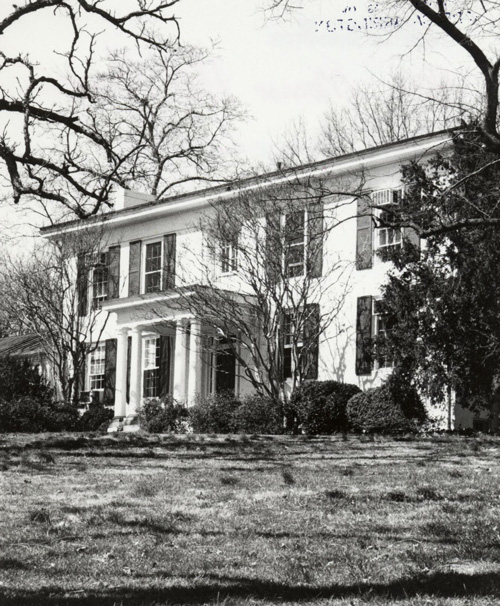
1 James Monroe, the United States’ fifth president, builds his law office and home at what would become the Monroe Hill Complex, atop Monroe Hill. In 1814, John Perry, a builder working on UVA and Monticello, buys the property and enlarges the house. Perry sells the property to be held in trust as the future site of UVA in 1817. In 1848, UVA adds two one-story dormitory wings.
Circa 1800
2 Farmer John Alphin builds Sunnyside. The now-Gothic Revival structure is updated and expanded in 1858, modeled after Washington Irving’s home of the same name in Tarrytown, New York. In 1963, UVA purchases the property, which is now part of North Grounds and is usually used for faculty and staff housing.
Oct. 6, 1817
3 With James Monroe, James Madison and Thomas Jefferson in attendance, the first cornerstone for what was called Central College is laid for a building that will eventually become Pavilion VII on West Lawn.
1818–1824
4 Workers—some who are enslaved and some who are not—build the Academical Village. In June 1818, workers start construction of Pavilion III and some Lawn rooms. By October 1819, construction is underway on seven pavilions and about 36 Lawn rooms. As work continues on the Lawn and Ranges, the Board of Visitors approves the construction of the Rotunda in April 1821.

In October 1822, construction on all buildings except the Rotunda is finished. The Rotunda’s dome is covered in summer 1824. By November 1824, while construction is underway on the Rotunda, Jefferson and Madison hold an event there for the Marquis de Lafayette.
1819–20
5 Off Montebello Circle, Montebello is originally built as a private home by Perry, who also built UVA and Monticello and enlarged Monroe Hill. UVA purchases the building in 1963; it’s used as faculty housing.
1825
UVA opens on March 7.
1825

6 Construction starts on the Anatomical Theatre, which Jefferson designed, deeming it essential for medical classes. The building across the street from the West Range is in use by early 1827. In 1886 it sustains damage in a fire and is later renovated; in 1924 it is condemned.
1826
Thomas Jefferson dies on July 4.
7 Around this time, the Crackerbox is built behind the East Range and used as a kitchen and quarters for enslaved workers. It later serves as a garage and, in 1960, was turned into its current use: a dorm for two students.
1828

8 The Rotunda is complete. Construction totals $60,000. Steps leading to the Rotunda’s south portico are constructed four years later.
1828
9 The first person is buried in the University Cemetery at Alderman and McCormick roads: Dr. Henry William Tucker, a professor’s brother, who was among the first to die in a typhoid epidemic that year. The cemetery’s plots sell out by 1966, and a columbarium is approved in 1987.
1829

10 The Mews opens as kitchen quarters for enslaved people who worked in Pavilion III. The building is expanded in 1881 and the 1930s. It’s now used as apartments.
1831–1856
11 McGuffey Cottage, just off the Lawn, is built at some point during this time span. It is originally used by enslaved laborers for professors living in Pavilion IX.
1835
12 The Morea House is built by John Patten Emmet, appointed by Jefferson as UVA’s first natural history professor. UVA purchases the property in 1960, and it is now part of the International Residential College.
1840
13 What’s left of the dormitories built on Carr’s Hill, the two-story Carr’s Hill Cottage, provides space for an office and guest cottage.
1851 to 1854
A four-story wing and a basement with room for classrooms, labs and an auditorium are attached to the Rotunda’s north side.
1855
14 Dawson’s Row begins to take shape with the opening of a parsonage, Dawson’s Row #4. It’s now home to UVA’s Office of African-American Affairs. Dawson’s Row #3, now home to the Luther Porter Jackson Black Cultural Center, was likely used by enslaved laborers, though its construction date isn’t known. In 1859, UVA builds six dormitories, called Dawson’s Row, opening a seventh a few years later. At some point between 1891 and 1907—records are unclear—Dawson’s Row #2, now the W.E.B. Du Bois Tutorial Center, opens. The Dawson’s Row dorms are torn down between 1931 and 1953.
1856
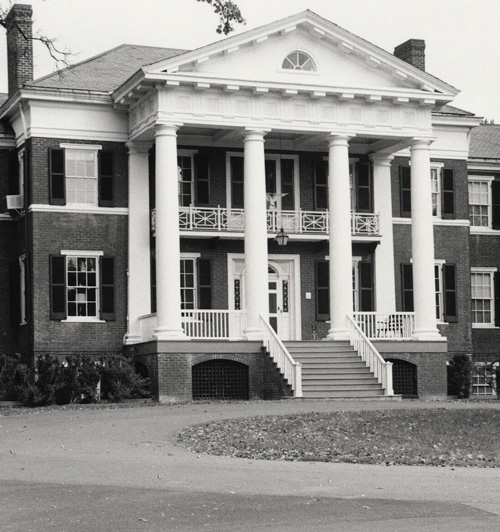
15 The house that will later be named Faulkner House, after author William Faulkner, is built. UVA purchases the house in 1963 and uses it as a guest house. Starting in 1975 it serves as the Miller Center’s headquarters.
1856
16 Buckingham Palace, a two-room cottage, is built on Carr’s Hill as a private home for two students. UVA purchases the Carr’s Hill property in 1867 and has used it as a student residence, for Delta Kappa Epsilon fraternity and, most recently, as a guesthouse for Carr’s Hill visitors.
1857–1858
UVA’s first indoor gym, 17 Squibb Gymnasium (now called Levering Hall), and an 18 infirmary (now named Varsity Hall), are under construction near East Lawn. The infirmary, built at a cost of $7,500, is the first built for this specific purpose on a U.S. campus.
Post-Civil War–1900
1858 to 1867
For nine years during and after the Civil War, no large-scale construction takes place.
1868
19 Miller Hall is built as a chemistry lab. It later serves UVA’s admissions department.
1877

20 When it opens, the Lewis Brooks Museum of Natural Science is one of the first natural history museums in the United States. By the late 1940s the building, while still called Brooks Museum, is used as classroom and faculty office space. In 1973 the Board of Visitors renames the building Brooks Hall. It is home to UVA’s anthropology department.
1883
21 The Alden House is built atop Observatory Hill. By the 1930s, it hosts official UVA receptions and dinners. In the 1960s, it’s turned into housing for faculty. From the late 1970s to 2002, it’s a home for astronomy graduate students. It’s now been vacant for more than two decades.
1884

22 The Leander McCormick Observatory, then the second-largest telescope in the world and built for $64,000, is dedicated in 1885 on Thomas Jefferson’s birthday, April 13, a few months after it was completed.
1888
23 A student-run dining hall is built on Carr’s Hill; students work as cooks and waiters. Part of the building, now called Leake Cottage, remains. UVA uses the space to prepare for events at Carr’s Hill.
1890
24 With funding from the local YMCA and Ladies Chapel Aid Society, the University Chapel opens. In 1897 the Drama Club donates a 1,200-pound bronze bell. Various renovation projects are launched in 2006, 2021 and 2023.

1892
25 The Dispensary, which includes examination rooms and a lecture hall for the medical school, opens on University Avenue. It is torn down in 1916.
1893

26 UVA builds another gymnasium: Fayerweather Hall. It’s located next to Madison Bowl, which opened not long before it and was operated by a local YMCA chapter, the United States’ first university chapter. When Memorial Gymnasium opens in 1924, Fayerweather becomes home to the School of Architecture. The building, now home to UVA’s art department, gets a full renovation that’s completed in 2006.
Oct. 27, 1895
Bad wiring sparks a fire that destroys the Rotunda and its annex.

1896
UVA hires the architectural firm McKim, Mead and White to design the new Rotunda and three buildings at the southern end of the Lawn, which will eventually be named Rouss, Cocke and Old Cabell halls.
1898
The rebuilt and redesigned Rotunda is dedicated. Architect Stanford White’s design includes two floors, instead of Jefferson’s three, a larger Dome Room, and east and west wings on the building’s north side.
1898
27 The South Lawn takes shape. Rouss, Cabell (now Old Cabell) and Cocke halls open. The project, historians have speculated, may have been, in part, to shield the Lawn from a nearby African American community called Canada.
1899
28 The “first modern residential hall” at UVA, Randall Hall, designed by Library of Congress architect Paul Pelz, opens with 43 rooms. It’s now home primarily to UVA’s sociology department.
1900–WWII
1901
29 University Hospital opens on Jefferson’s birthday, April 13, with capacity for 150 beds. Architect Paul Pelz designed the building with growth in mind, and the complex has grown rapidly ever since, with wings opening in 1905, 1907, 1916, 1924, 1928 and 1941.

1902
30 The first games are played at Lambeth Field, once a dairy farm.
1902
31 Saint Anthony Hall’s chapter house opens on Chancellor Street. It’s the first house built as a fraternity at UVA. More houses are to follow in the Rugby Road area, primarily in the 1910s and 1920s.
1905
32 The local YMCA chapter builds Madison Hall as its home.

1908
33 After a years-long lobbying effort by UVA’s first president, Edwin Alderman, to build a dining hall to boost fellowship opportunities on Grounds, Garrett Hall opens to serve both students and faculty. First called the Refectory and then The Commons, the building replaces a mess hall on Carr’s Hill and would undergo updates in 1959, 1983 and 2011. It’s now home to UVA’s Batten School.
1909

34 After two years of construction, Carr’s Hill, home to UVA’s presidents, is complete. A carriage house, now used for storage, had been finished the year before.
1911
35 UVA’s law school moves from the Rotunda to Minor Hall with the building’s opening.
1913
36 The Lambeth Colonnades, an 8,000-seat stadium, opens for its first season, replacing the field’s wooden grandstand.
1914
37 Peabody Hall opens as a home for the new education school. A fire shuts it down in 1973; it reopens in 1982. In 2001, a 13-month full renovation wraps up. The building is now home to UVA’s admissions department.
1917
38 Cobb Hall is built and used by UVA’s chemistry department. The building is currently under construction as part of a project to expand space for the commerce school.
1921
39 McIntire Amphitheatre, which costs $85,000 to build, opens and marks the University’s 1919 centennial a couple of years late, postponed by World War I. U.S. President Woodrow Wilson (Law 1880) attends. In 1967 the amphitheater’s grassy lawn is paved for a parking lot but is returned to grass less than a decade later. A gravel walkway that provides a border between the seats and the amphitheater’s lawn, part of the original design, returns in 2010.
1924
40 Memorial Gymnasium opens, replacing Fayerweather Hall, which was just one-third its size. It becomes the home to boxing, the University’s biggest sport at one time, as well as home court for UVA basketball until University Hall opens in 1965. The building served as a memorial for the 80 students and alumni who died during World War I. The gym’s original floor is replaced in 1992; in 2005 its gym and locker rooms are updated. The building is undergoing massive exterior and interior renovations currently, which started around 2017.

1929
41 Faced with crowding as more students enroll after World War I, UVA opens 12 dormitories for first-years just west of Monroe Hill. The buildings, or “portals,” are named after 19th century professors. In 1986, the dorms are renovated and turned into Monroe Hill Residential College, now Brown College, UVA’s first residential college.
1930
42 Monroe Hall opens, originally for UVA’s economics and commerce programs. It houses UVA’s graduate business school from 1955 to 1975, and its undergraduate business school from 1975 to 2008. In 1987 the building gets more space and a new façade.
1931
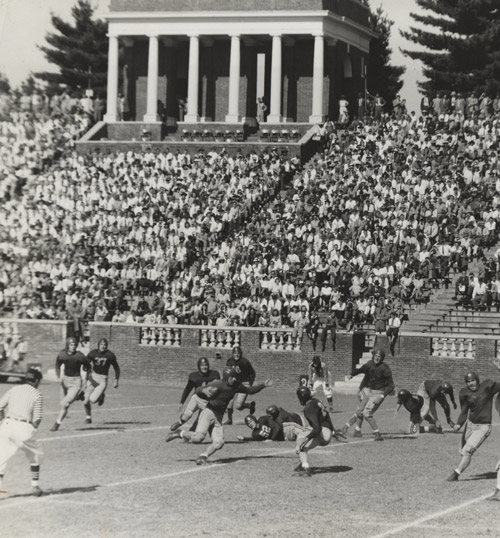
43 Scott Stadium, among the oldest college football stadiums in the United States, opens and is dedicated during the Oct. 15, 1931, game against Virginia Military Institute. It replaces Lambeth Field. The stadium has undergone numerous updates since then. Once designed for 22,000, it can now hold more than 60,000.
1931
44 McKim Hall, a nursing school dorm, opens, serving 53 students—UVA’s largest nursing class at the time—and the program’s first full-time faculty member.
1932
45 Clark Hall opens as a new home for UVA’s law school, which had moved from Pavilion III to the Rotunda Annex in 1853 and then to Minor Hall in 1911. Space is added a handful of times, including in 1950, 1952, 1961 and 2003.
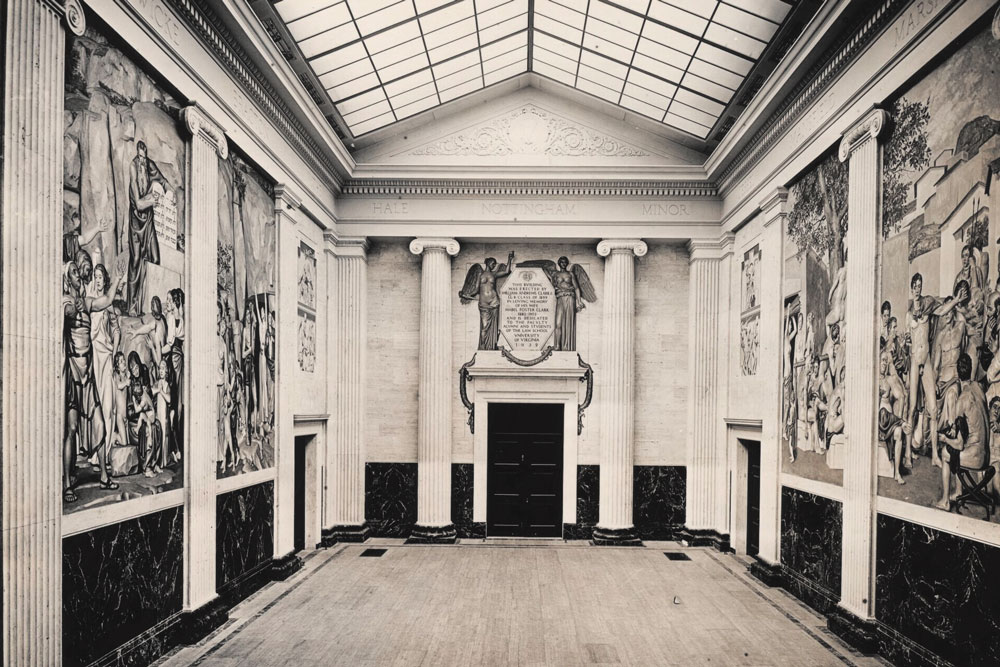
1935
46 Thornton Hall opens, becoming home to UVA’s engineering school 100 years after the school launched in 1836. It’s the first academic building west of Emmet Street. Additions are built twice in the 1950s and some changes are made in the 2010s.
47 The Bayly Building opens as a home for UVA’s art collection. Originally named the University of Virginia Art Museum, it becomes the Fralin Museum of Art in 2012. Between 1939 and 1946 it closes because of World War II; an annex is added a short while after it reopens. Starting in 1962 it is used for academic purposes because of space shortages, and then is extensively renovated and reopens as an art museum in 1974. In 2021 the museum reopens after a 17-month closure for renovations, including a new roof, and because of the COVID-19 pandemic.
1936
48 The Alumni Association purchases the former Kappa Phi House on Emmet Street and moves there from Pavilion VII. The building, Alumni Hall, is expanded in 1983 and 1991.
1938
49 UVA’s library gets a much bigger home, moving from the Rotunda to the new Alderman Library. The “new stacks” are added in 1967. In 2020 the library closes for a massive $160 million renovation and expansion that includes replacing 130,000 square feet of space and renovating 100,000 square feet of the existing building. It is scheduled to reopen in 2024.
1939
50 Mary Stuart Cocke Goodwin, whose late husband was a UVA professor of surgery, builds a home on the south side of Sprigg Lane. UVA buys the home in 1964, and it becomes Bemiss House, headquarters for the University of Virginia Press in 1968. In 1991 it is expanded.
The Anatomical Theatre is demolished. It is the only Jefferson-designed building to be torn down.
WWII–1970
1942
51 Maury Hall, renamed Warner Hall in 2022, opens as a home base for UVA’s Naval ROTC program. In 1953 Naval ROTC expands into Halsey Hall, now home to UVA’s statistics department, next door.
World War II forces a slowdown on construction projects as funding sources dry up.
1948
52 University Gardens, graduate student housing off Emmet Street, opens. The complex includes 60 apartments across eight buildings. In September 2022, the BOV’s Buildings and Grounds Committee votes to demolish them.
1951
53 Built between 1946 and 1951, UVA’s “Old Dorms” along McCormick Road open. Between 2018 and 2020, each Old Dorm gets a reboot to include new laundry rooms, kitchens and air-conditioning.
1952
54 Mary Munford Hall opens. It’s the first residence hall for women.
55 New Cabell Hall, with a construction cost of $1.6 million, opens to add classroom space and academic offices for a growing student body. A four-year project is finished to update the space in 2014.
1954
56 The Physics Building opens; in 1980 and 1993 it is expanded. In September 2022, the BOV’s Buildings and Grounds Committee approves the design for a future classroom renovation.
1958
57 Newcomb Hall opens as UVA’s student activities center. In 1997 a $16.4 million renovation project that forced some student groups to move out of Newcomb is complete. In 2013, a three-year, $33 million renovation wraps up and includes upgrades to the dining hall, theater and ballroom.
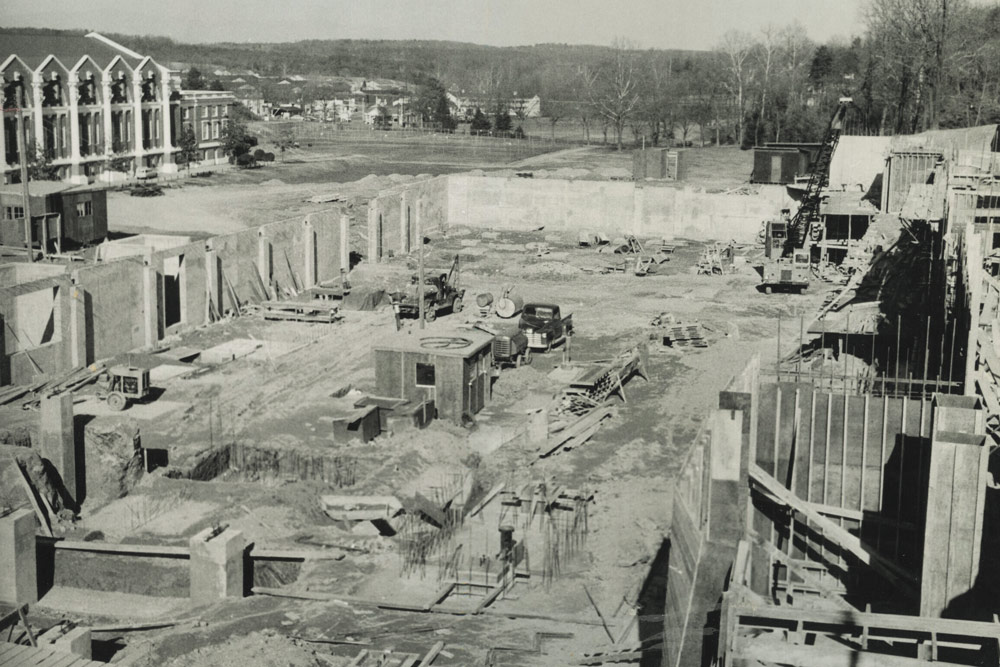
1960
58 UVA opens a nuclear reactor atop Observatory Hill for research as part of its nuclear engineering program. It closes in 1998.
59 Olsson Hall opens. In 2018, the building’s top floor is transformed into the engineering school’s Link Lab.
1963
60 Gilmer Hall opens as the home for biology and psychology at UVA. In 1987 an expansion makes room for more neuroscience research labs. In 2022 a full renovation completely remakes the building, allowing in more light and better space for research.

1964 to 1966
61 Suite-style dorms, quickly nicknamed “New Dorms,” emerge off Alderman Road. First come Courtenay, Dunglison, Fitzhugh, Dunnington, Tuttle, Lile and Maupin houses in 1964. Balz, Dobie, Watson and Webb follow in 1966. [61a]Starting in 2006, the New Dorms are torn down and replaced with seven residence halls. Courtenay, Dunglison and Fitzhugh are the only original New Dorms to remain.
1965
62 The Chemistry Building opens next to Gilmer Hall, then just 2 years old. In 2020 a massive renovation modernizes research labs and updates the building.

63 University Hall opens as the new home for UVA basketball, moving from Mem Gym. The final basketball games are played in the building in 2006 when the teams move to John Paul Jones Arena.
1970–2000
1970
64 Campbell Hall opens as the home for UVA’s architecture program, moving from Fayerweather Hall. The building is renovated and expanded in 2008, including the addition of a new south wing and east tower.
65 As UVA begins to admit more women, Gwathmey House opens.
1971
66 Lannigan Field opens as the home of UVA’s track and field teams. In 2012, a $14 million renovation replaces the track and makes other improvements.
1972
67 Bice House, a nine-story dormitory, opens. A project to update and modernize the space finishes in 2004.
68 McLeod Hall, a nursing education building, and Jordan Hall, a medical education building, open. In 2016, Jordan Hall, named after onetime medical school dean Harvey Jordan, who was involved in the eugenics movement, is renamed Pinn Hall after Dr. Vivian Pinn (Med ’67), the only woman and minority member of her medical school class. The building was undergoing a renovation at the time to add 25 percent more usable space.
1973
69 Ruffner Hall opens for the education school. The building gets a major renovation in 2013 and 2014 and is renamed Ridley Hall in 2020, after Walter N. Ridley (Educ ’53), UVA’s first Black student to earn a doctoral degree.
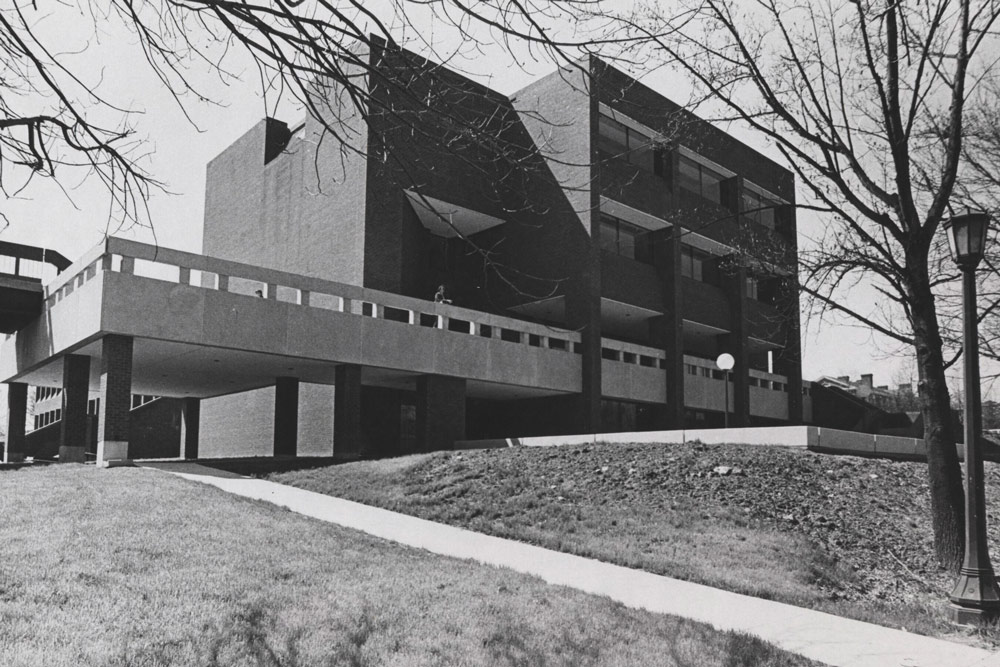
1974–1975
70 North Grounds takes shape. UVA’s law school moves from Clark Hall to its new building, eventually named Henry Malcolm Withers Hall, now Brown Hall, in 1974. Darden, which had been in Monroe Hall, and the Judge Advocate General School follow to North Grounds in 1975. In the 1990s North Grounds undergoes another series of moves. The Darden campus is built in 1992. The David A. Harrison III Law Grounds opens in 1997.

1974
71 The Drama Department Building, with an attached theater, opens off Culbreth Road.
72 Lambeth Field Apartments open, offering a new housing option for students.
1976
A years-long effort to return the Rotunda to its original design is completed in time for the country’s bicentennial. The goal is to “correct the alterations” made by the architect who designed its replacement after the 1895 fire. The project, which closes the Rotunda for two years, includes returning it to Jefferson’s original three stories, and replacing the roof and oculus.
1979
73 Slaughter Recreation Center on Edgemont Road opens. It now serves intramural sports. A climbing center opens there in 2018.
1982
74 Clemons Library opens. The building is updated over the years, including the opening of the Robertson Media Center in 1999 and a new third-floor roof, also Clemons Plaza, in 2007 and 2008.
1983–1984
75 As the student population grows, UVA adds more dorm rooms. Hoxton and Yen (formerly Lewis) houses are built, adding new dormitory space. They are part of UVA’s International Residential College, which includes Munford and Gwathmey off Emmet Street.
76 On the other side of Grounds, off Alderman Road, the Gooch-Dillard Residence Halls open in 1984. The buildings are renovated in 2016 and 2017. 1984 77 UVA opens the Birdwood Golf Course.
1989
78 An eight-story University Hospital opens.
79 UVA acquires what is now called the Boar’s Head Resort.
1991
80 McCue Center opens to serve UVA’s football team.
1992
81 The engineering school’s Chemical Engineering Building opens.
82 Hereford College, originally called New College, and Runk Dining Hall open.
83 Klockner Stadium, a $3.4 million complex serving UVA’s soccer and lacrosse teams, opens in August 1992.
1994
84 A new University Bookstore and Central Grounds Garage open.
85 The UVA Foundation acquires and begins developing the 54-acre Fontaine Research Park in the mid-1990s and begins the work to transfer ownership to UVA in 2017. UVA is currently moving forward on plans to develop the Manning Institute of Biotechnology there.
1995
86 UVA’s English Department moves into its new home, Bryan Hall, behind the McIntire Amphitheatre. 1
87 Ivy Stacks, described as a “high-density storage and retrieval facility” for UVA’s library system, opens on Old Ivy Road. A two-year renovation and retrofit is finished in 2012, and the facility is doubled in fall 2017 and spring 2018.

1996
88 A new dorm, Cauthen House, opens. At the time, it is the only first-year residence that includes classrooms and a computer lab.
89 UVA’s Aquatic and Fitness Center opens with a pool, fitness rooms and classrooms. In 2004, a three-court gym, indoor track and additional workout space is added. In 2009, a 5-meter platform tower is added for UVA’s diving program.
Late 1990s
Old Cabell Hall is renovated. The work makes it accessible and updates seating in the auditorium. Artist Lincoln Perry starts to paint “Students’ Progress,” a mural in Old Cabell’s lobby, finishing in 2012.
2000–present
2000
90 A new dorm, Woody House, opens.
2002
91 The law school completes a new student-faculty center.
92 Davenport Field at Disharoon Park opens. A $4.5 million expansion is finished in 2010, followed by a $18.8 million expansion in 2018.
93 Medical Research Building 5 opens with space for biomedical scientists and engineers.
94 UVA completes construction on Shea House, a language-immersion house at Monroe Lane and Jefferson Park Avenue.
2004
95 A $1.5 million project to update the Dell transforms the area off Emmet Street, solving stormwater runoff issues and turning it into a park and gathering space.
96 The Albert and Shirley Small Special Collections Library opens on Central Grounds with room for 13 million manuscripts, 325,000 rare books, 250,000 photographs and small prints and other items. Miller Hall is torn down in 2002 to make way for the library.

2005
As part of work to expand Rouss Hall, 600-ton Varsity Hall is moved 185 feet.
2006
97 John Paul Jones Arena opens as the new home to UVA basketball. The $130 million facility includes 15,000 seats and 54 concession stands.
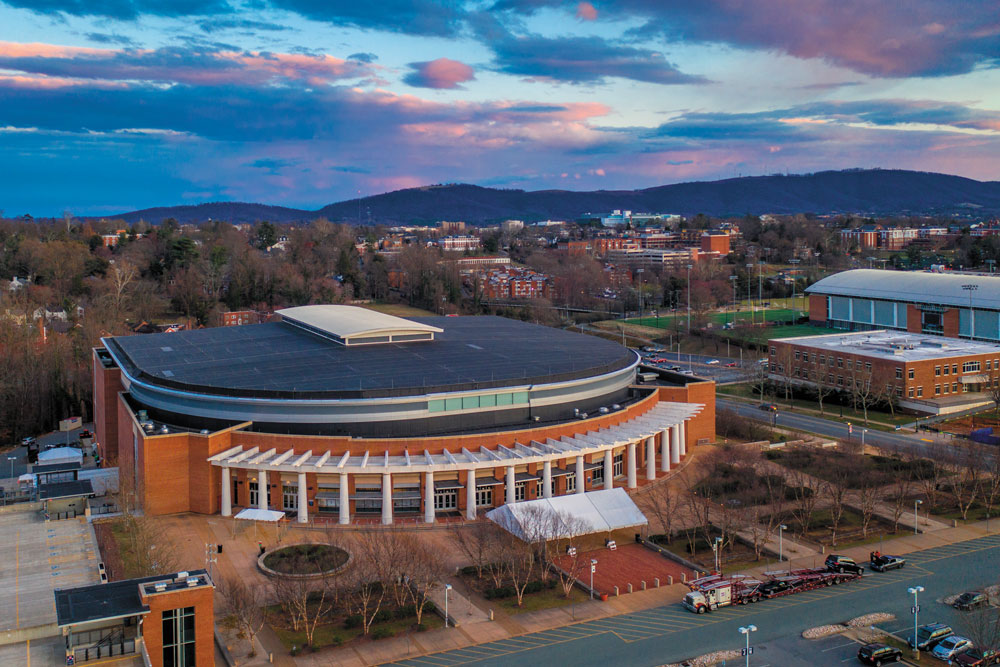
98 Wilsdorf Hall opens to serve the engineering school. The $43.4 million, 99,000-square-foot, five-story building is designed to support research in materials science and engineering, chemical engineering and nanotechnology.
A $9 million project to update Cocke Hall is finished, including restoration of the building’s clock, which had been broken for decades.
2008
99 The $15.6 million Claude Moore Nursing Education Building opens with 32,000 square feet of academic spaces, offices and common areas.
100 The commerce school moves back to the Lawn with the opening of an updated Rouss Hall and the construction of the new Robertson Hall. Together, the two buildings provide 156,000 square feet of space.
101 As an expansion of the Arts Grounds, Ruffin Hall, home to UVA’s studio art department, opens. The $25.9 million project spans 42,000 square feet.
2009
102 The $70.7 million, 102,000-square-foot Carter-Harrison Research Building opens, serving UVA’s health system.
2010
103 South Lawn, dubbed “the most ambitious extension of the Lawn” since Rouss, Cocke and Old Cabell halls were built in the late 1890s, opens. The $102.5 million project adds 116,000 square feet for the history, politics and religious studies departments. A pedestrian bridge over Jefferson Park Avenue connects Central Grounds with South Lawn, which includes Nau and Gibson Halls and a commons building.
104 The Jefferson Scholars Foundation opens its complex of four buildings, totaling 32,700 square feet.
105 Called the “most technologically advanced medical school facility in the nation” when it opens, the Claude Moore Medical Education Building serves the school’s largest class at the time. The $40 million building is five stories.
106 Next to then-Ruffner (now Ridley) Hall, $37.4 million Bavaro Hall opens, a 65,000-square-foot building that almost doubles the education school’s academic and office space.
2011
107 The $12.7 million Hunter Smith Band Building on Culbreth Road opens, providing a permanent home for UVA’s band program.
108 The $75 million Physical and Life Sciences Research Building opens with five levels for biology, chemistry and physics researchers.
109 The engineering school opens the Rice Hall Information Technology Engineering Building, a six-story, 100,000-square-foot, $65.5 million building.
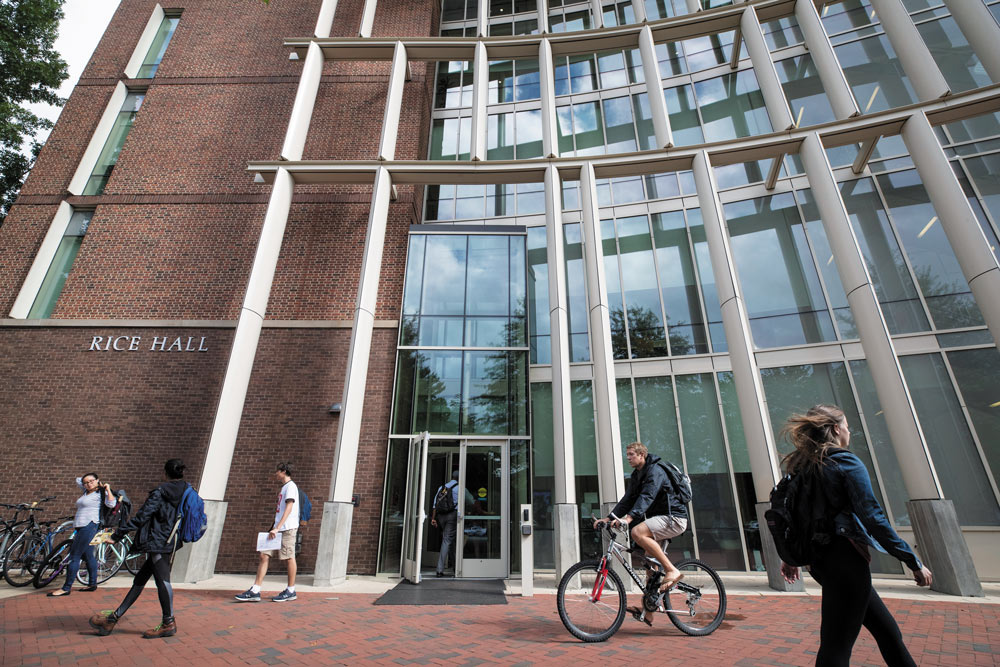
2013
110 Lacy Hall, a $5 million, 20,000-square-foot, four-story building, opens to serve UVA’s engineering school.
The $12.4 million McArthur Squash Center at the Boar’s Head Sports Club opens as the home court for UVA’s men’s and women’s squash teams, which both become varsity sports a few years later.
111 The $13 million, 78,000-square-foot George Welsh Indoor Practice Facility opens with room for a full-sized football field.
2015
112 Gibbons House, a new five-story dorm, opens. It’s named after William and Isabella Gibbons, a couple who were enslaved by different UVA professors living in Pavilions in the mid-19th century.
2016
An extensive four-year, $58 million restoration to the Rotunda is complete. The work repairs the roof and stabilizes and modernizes the building.
2017
113 In an 1896-era building on The Corner, a new student center called 1515 opens.
2019
Carr’s Hill reopens after a two-year, $13.9 million project to repair, renovate and update the historic building.
114 UVA expands its presence off Brandon Avenue with the opening of Bond House, a six-story dormitory.

U-Hall is demolished.
2020
115 Palmer Park, the new home for UVA softball, opens at the corner of Massie and Copeley roads.
2021
116 UVA’s Student Health and Wellness building, a $100 million, 156,000-square-foot complex on Brandon Avenue, opens.
